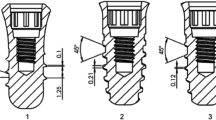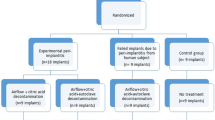Abstract
Objectives
Primary healing of dental implants is influenced by their surface morphology. However, little is known about any alterations in morphology during their insertion. Therefore, the aim of this study was to evaluate the surface morphology of four different implant systems, following their insertion in porcine jaw bones.
Methods
Four fresh porcine mandible specimens were used. Six new implants of four systems (Ankylos® 4.5 × 14 mm, Frialit Synchro® 4.5 × 15 mm, NobelReplace ® Tapered Groovy RP 4.3 × 13 mm, Straumann SLA® Bone Level 3.3 × 14 mm) were inserted, whereas one implant of each system served as a control. After their removal, implants were cleaned in an ultrasonic bath. All 28 implants were examined quantitatively by 3D confocal microscopy for surface characteristics.
Results
In the evaluated zones, implants of the Ankylos, Frialit, and Straumann systems showed mostly a reduction of the mean surface roughness Sa, the maximal surface roughness Sz, and the developed surface area ratio Sdr; Nobel implants showed an increase in these parameters. With respect to all three parameters Sa, Sz, and Sdr, statistical analysis revealed that differences between the four systems were highly significant in the apical region of implants. Controls showed no morphologic alterations.
Conclusion
The insertion process had an impact on the surface of all four implant systems. Anodized implant surface modification seems to result in more alterations compared with subtractive surface modifications. Therefore, surgical planning should take into consideration the choice of surface treatment because the characteristics of the implants may be modified during the installation process.
Clinical relevance
The given information is of value for daily implantation practice and the course of osseointegration.







Similar content being viewed by others
References
Thomason JM et al (2009) Mandibular two implant-supported overdentures as the first choice standard of care for edentulous patients—the York consensus statement. Br Dent J 207(4):185–186
Mints D et al (2014) Integrity of implant surface modifications after insertion. Int J Oral Maxillofac Implants 29(1):97–104
Albrektsson T et al (1981) Osseointegrated titanium implants. Requirements for ensuring a long-lasting, direct bone-to-implant anchorage in man. Acta Orthop Scand 52(2):155–170
Ruger M et al (2010) The removal of Al2O3 particles from grit-blasted titanium implant surfaces: effects on biocompatibility, osseointegration and interface strength in vivo. Acta Biomater 6(7):2852–2861
Mata A et al (2003) Osteoblast attachment to a textured surface in the absence of exogenous adhesion proteins. IEEE Trans Nanobioscience 2(4):287–294
Choi JW et al (2006) Biological responses of anodized titanium implants under different current voltages. J Oral Rehabil 33(12):889–897
Deppe H et al (2015) Surface morphology analysis of dental implants following insertion into bone using scanning electron microscopy: a pilot study. Clin Oral Implants Res 26(11):1261–1266
Pawley J (2006) Handbook of biological confocal microscopy, 3rd edn. Springer, Berlin
Sartoretto SC et al (2015) Early osseointegration driven by the surface chemistry and wettability of dental implants. J Appl Oral Sci 23(3):279–287
Wennerberg A, Albrektsson T (2000) Suggested guidelines for the topographic evaluation of implant surfaces. Int J Oral Maxillofac Implants 15(3):331–344
Arvidsson A, Sater BA, Wennerberg A (2006) The role of functional parameters for topographical characterization of bone-anchored implants. Clin Implant Dent Relat Res 8(2):70–76
Brown CA, Johnsen WA, Hult KM (1998) Scale-sensitivity, fractual analysis and simulations. Int J Mach Tools Manufact 38:633–637
Misch CE (1999) Bone density: a key determinant for clinical success. In: Misch CE (ed) Contemporary implant dentistry, 2nd edn. CV Mosby Company, St Louis
Cooper LF (2000) A role for surface topography in creating and maintaining bone at titanium endosseous implants. J Prosthet Dent 84(5):522–534
Trisi P et al (2003) Bone-implant contact on machined and dual acid-etched surfaces after 2 months of healing in the human maxilla. J Periodontol 74(7):945–956
Pak HS, Yeo IS, Yang JH (2010) A histomorphometric study of dental implants with different surface characteristics. J Adv Prosthodont 2(4):142–147
Bouwman JP, Tuinzing DB, Kostense PJ (1994) A comparative in vitro study on fixation of sagittal split osteotomies with Wurzburg screws, Champy miniplates, and biofix (biodegradable) rods. Int J Oral Maxillofac Surg 23(1):46–48
Mosekilde L (1995) Assessing bone quality—animal models in preclinical osteoporosis research. Bone 17(4 Suppl):343S–352S
Wennerberg A et al (1995) A histomorphometric and removal torque study of screw-shaped titanium implants with three different surface topographies. Clin Oral Implants Res 6(1):24–30
Ballo AM et al (2011) Dental implant surfaces—physicochemical properties, biological performance, and trends. In: Turkyilmaz PI (ed) Implant dentistry—a rapidly evolving practice. InTech
Albrektsson T, Wennerberg A (2004) Oral implant surfaces: part 1—review focusing on topographic and chemical properties of different surfaces and in vivo responses to them. Int J Prosthodont 17(5):536–543
Wennerberg A et al (1992) An optical three-dimensional technique for topographical descriptions of surgical implants. J Biomed Eng 14(5):412–418
Wennerberg A et al (1997) A 1-year follow-up of implants of differing surface roughness placed in rabbit bone. Int J Oral Maxillofac Implants 12(4):486–494
Wennerberg A, Albrektsson T, Andersson B (1996) Bone tissue response to commercially pure titanium implants blasted with fine and coarse particles of aluminum oxide. Int J Oral Maxillofac Implants 11(1):38–45
Wennerberg A et al (2004) Titanium release from implants prepared with different surface roughness. Clin Oral Implants Res 15(5):505–512
Valente ML, Lepri CP, dos Reis AC (2014) In vitro microstructural analysis of dental implants subjected to insertion torque and pullout test. Braz Dent J 25(4):343–345
Guan H et al (2009) Influence of bone and dental implant parameters on stress distribution in the mandible: a finite element study. Int J Oral Maxillofac Implants 24(5):866–876
Schliephake H et al (1993) Metal release from titanium fixtures during placement in the mandible: an experimental study. Int J Oral Maxillofac Implants 8(5):502–511
Goodman SB, Ma T (2010) Cellular chemotaxis induced by wear particles from joint replacements. Biomaterials 31(19):5045–5050
Bukata SV et al (2004) PGE2 and IL-6 production by fibroblasts in response to titanium wear debris particles is mediated through a Cox-2 dependent pathway. J Orthop Res 22(1):6–12
Tanaka M et al (1994) Effects of bone tapping on osseointegration of screw dental implants. Int J Oral Maxillofac Implants 9:541–547
Funding
The work was not funded.
Author information
Authors and Affiliations
Corresponding author
Ethics declarations
Conflict of interest
The authors declare that they have no conflict of interest.
Ethical approval
This article does not contain any studies with human participants or animals performed by any of the authors.
Informed consent
For this type of study, formal consent is not required.
Rights and permissions
About this article
Cite this article
Deppe, H., Wolff, C., Bauer, F. et al. Dental implant surfaces after insertion in bone: an in vitro study in four commercial implant systems. Clin Oral Invest 22, 1593–1600 (2018). https://doi.org/10.1007/s00784-017-2262-4
Received:
Accepted:
Published:
Issue Date:
DOI: https://doi.org/10.1007/s00784-017-2262-4




